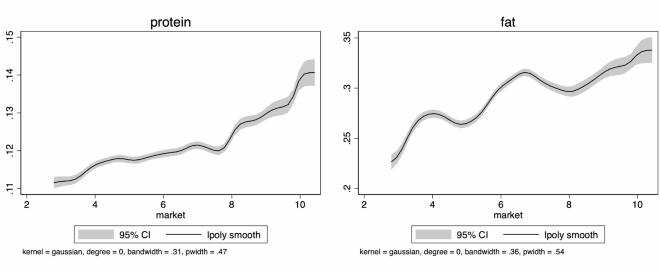Baseline regression
This paper empirically tests the impact of market integration on residents’ health by constructing a probit model. Table 2 reports the regression results for Model (1). The results indicate that market integration significantly reduces the incidence of illness among residents. For every one-unit increase in the level of market integration, the probability of illness decreases by approximately 1.45%. This means that the promotion of market integration has tangible benefits for public health. For example, in a region with a population of 10 million, a 1.45% reduction in disease incidence could mean 145,000 fewer cases of illness per year. This effect not only reduces the medical burden and alleviates the pressure on the healthcare system, but also provides a healthier workforce to support economic growth. The results for the control variables are largely as expected. At the individual level, the probability of illness increases with age. Additionally, males, individuals with a higher BMI, those suffering from chronic diseases, and those living in rural areas are more likely to be ill. At the family level, a larger family size tends to decrease the incidence rate. Poorer toilet facilities in the household are associated with a greater likelihood of illness. At the community level, for every one-unit increase in urbanization, the illness rate among residents increases by approximately 0.11%. At the regional level, economic growth has a significant inhibitory effect on local morbidity rates; a 1% increase in the economic growth rate leads to a 39.80% reduction in the illness rate.
Additionally, this paper replaces the market integration variable (Market) in Model (1) with five subindices measuring aspects of market integration and conducts regression analyses, the results of which are shown in Table 3. The indices for government-market relations (relation), factor markets (factor), and legal and institutional frameworks (law) all reduce the incidence of illness among residents to some extent. Of these, a positive government-market relationship has the most significant negative impact on the incidence of illness, followed by market intermediation and the legal and institutional environment. While the development level of factor markets does reduce illness rates, its impact is relatively limited. There was no significant relationship between the level of nonfinancial economic development and local illness rates. Notably, for every unit increase in the development of product markets, the illness rate among residents increases by approximately 1.13%. The results for the control variables remain consistent with previous findings. Due to space constraints, the detailed coefficient estimates for the control variables can be found in SI Table 2 in the appendix. This suggests that an overly developed product market may have negative health impacts, such as promoting overconsumption or the spread of unhealthy products. However, this negative effect can be partially offset by other factors. It indicates that merely developing the product market is not enough to promote health; supportive institutional and policy environments are equally crucial. This calls for the government to play a more active role in managing the relationship between market development and public health.
Robustness test
(1) Replacement of the explanatory variable: This study substitutes the market integration index with a market segmentation index and incorporates it into Model (1) for regression analysis. According to the results in Table 4, an increase in the market segmentation index significantly increases the probability of illness among residents. This finding supports the previous conclusion that market integration can reduce the incidence of illness. Moreover, the results of the control variables remain consistent with previous findings. Due to space constraints, detailed estimates of the control variable coefficients can be found in SI Table 3 in the appendix.
(2) Replacement of the dependent variable: Considering that whether one has been ill or injured in the past four weeks may not fully capture the complexity of overall health status, this paper replaces the measurement with the following three approaches as part of a robustness check. First, individuals’ perceptions of “illness” or “injury” may vary, leading to potential bias in this variable. Therefore, “whether one sought medical care in the past four weeks” (hospitalize) is used as the dependent variable in a probit model regression. Second, different illnesses or injuries may vary in severity. Thus, this paper constructs “treatment type” (treatment) as the dependent variable to distinguish the severity of health problems. Specifically, values of 2, 1, and 0 are assigned to cases of inpatient treatment, outpatient treatment, and no treatment, respectively, and an ordered logit model is used for estimation. Finally, the logarithm of an individual’s medical expenses (cost) is also used as the dependent variable in a tobit model, aiming to better reflect the complexity of health status. The estimates presented in Table 5 are consistent with previous results.
(3) Change in sample scope: Previous research has confirmed that China’s accession to the WTO has impacted residents’ health levels20. To eliminate potential biases in the results due to the period before and after joining the WTO, this study removes data from the survey years 1997 and 2000, retaining only the data from 2004 to 2011 for regression analysis. Table 6 reports the empirical results after changing the sample scope. The results demonstrate that even after removing the data from the two years prior to China joining the WTO, the conclusion that market integration reduces the incidence of illness among residents remains valid.
(4) Inclusion of lagged variables: Considering that individual health levels vary, this study introduces a lagged variable of the dependent variable in Model (1) to exclude the possibility that previous trends in illness rates are correlated with market integration. According to the results in Table 7, after including the lagged variable, the conclusion that market integration reduces the incidence of illness among residents still holds. Moreover, the effects of the five subindices of the market integration index on illness rates remain consistent with the findings reported in Table 3.
(5) Replacement model: Table 8 presents the estimation results after changing the model. This paper uses a logit model to examine the potential relationship between market integration and health, and the results are consistent with the baseline results, indicating that market integration indeed promotes health. In addition, only about 13% of the sample was observed to have been ill or injured, which could be considered a rare event with low occurrence probability. Therefore, a complementary log-log (cloglog) model was further employed for estimation, and the results remain robust.
(6) Nonlinear relation: If the relationship between market integration and health is nonlinear, a linear model might produce misleading results. Therefore, this paper uses quantile regression and Box-Tidwell transformation to verify whether a nonlinear relationship exists between the two. Table 9 presents the results of the quantile regression. The inhibitory effect of market integration on disease incidence is significant across different sample intervals, with little variation in coefficients, suggesting that there is no significant nonlinear relationship between the two. The results of the Box-Tidwell transformation are shown in SI Table 4 of the appendix, where the insignificance of the interaction term’s coefficient similarly indicates that there is no nonlinear relationship.
(7) Instrumental variable: The relationship between market integration and residents’ health may involve a bidirectional causality issue. For example, a healthier population may be more productive and engage in more frequent economic activities. Therefore, improvements in health outcomes could also contribute to greater market integration. This paper selects the average nighttime light intensity at the provincial level (lamplight) as an instrumental variable. On the one hand, this variable reflects the level of economic development in a region; the higher the average light intensity, the more urbanized and economically developed the area is. On the other hand, no research has shown a direct link between average light intensity and residents’ morbidity, making it a suitable instrumental variable. Table 10 presents the estimation results using the instrumental variable, demonstrating that the choice of instrument is appropriate. Moreover, after using the instrumental variable, the regression results are consistent with the baseline results in direction, and the coefficients are close.
Heterogeneity
(1) Gender: Given that some diseases exhibit significant incidence rate disparities between genders, this study specifically examines how gender affects the impact of market integration on residents’ illness rates. The sample was divided into male and female groups, and Model (1) was applied separately for regression analysis. According to the results presented in Table 11, market integration has a more significant effect on reducing illness rates among males. Specifically, for every unit increase in market integration, the probability of illness among male residents decreases by approximately 2.97%. In contrast, this effect is less pronounced among females, suggesting that gender differences play a moderating role in the impact of market integration on illness rates. The differential impact of market integration on the health of male and female residents may stem from differences in biology, social roles, and health behaviors between the genders. Biologically, men and women exhibit significant differences in susceptibility to certain diseases, which may result in varied health effects of market integration between the sexes43. Additionally, the division of gender roles in society may influence health outcomes. Men often engage in more physically demanding jobs and are exposed to higher-risk work environments, making them more likely to benefit from the economic improvements and better working conditions brought about by market integration. Market integration promotes economic growth and labor mobility, potentially offering men more economic opportunities, which can improve their health. In contrast, women, who often bear more caregiving responsibilities and participate less in the labor market in many cultural contexts, may experience more limited health benefits from market integration44.
(2) Age: The sample was divided into three age groups: young (18–40 years), middle-aged (40–60 years), and elderly (over 60 years). The regression results reported in Table 12 indicate that the effect of market integration on reducing illness rates is particularly pronounced among elderly people. For every one-unit increase in market integration, the probability of illness among elderly people decreases by approximately 6.72%. Elderly people typically have greater susceptibility and incidence rates of diseasesSource
 Mind Uncharted Explore. Discover. Learn.
Mind Uncharted Explore. Discover. Learn.




